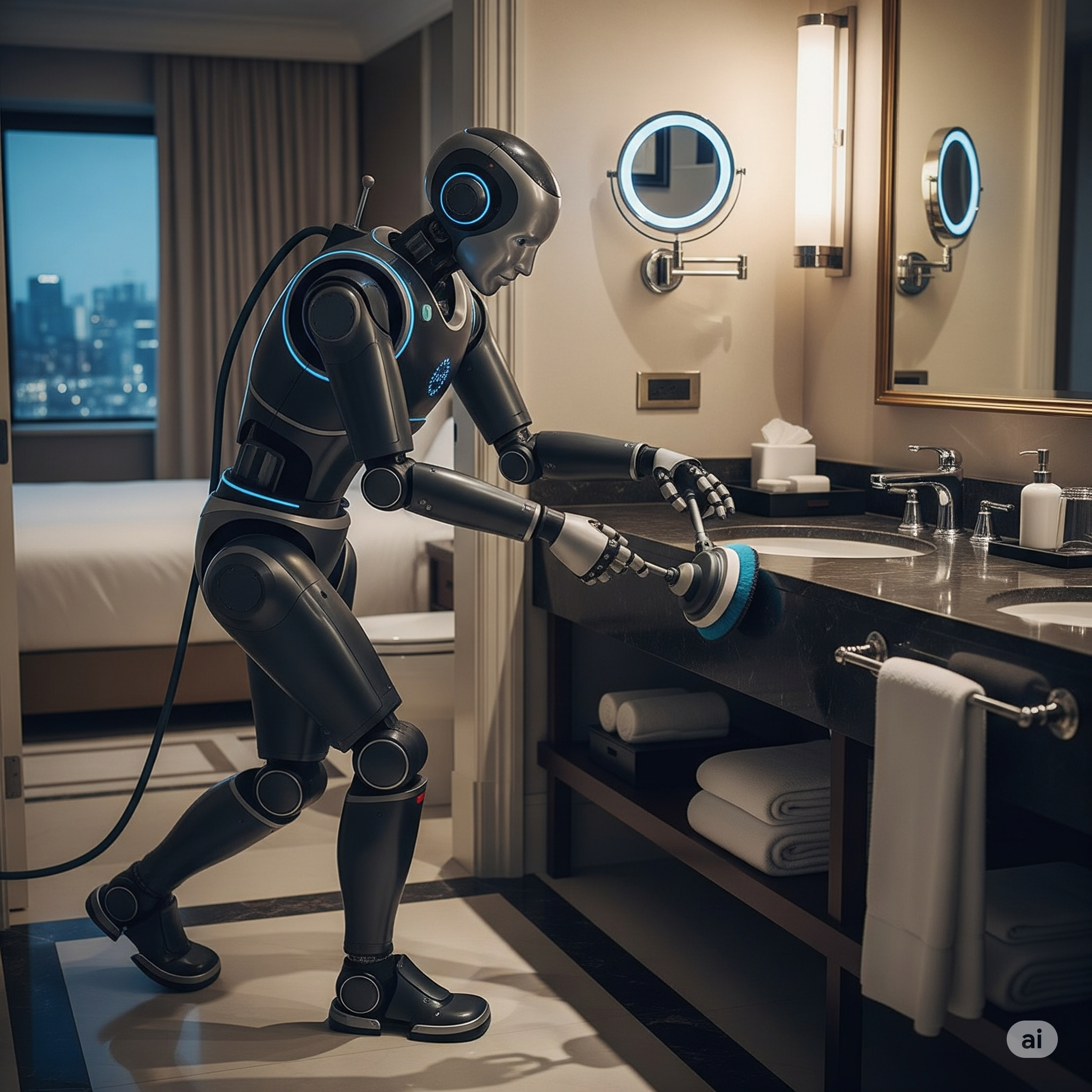Gist:
- Chinese tech firm Zerith has unveiled H1, a humanoid robot designed for hotel housekeeping tasks.
- This innovation marks a major leap in automating labor-intensive functions in the hospitality sector.
- The robot performs tasks like scrubbing toilets, refilling toiletries, and even interacting with guests.
- H1 represents a future where human-robot collaboration can redefine guest experiences and staff efficiency.
- The blog explores AI in hospitality, its implications for jobs, ethics, and future hotel design.

Imagine walking into a luxury hotel suite, only to find a friendly humanoid robot cleaning the bathroom, restocking towels, and offering you a bottle of water with a programmed smile. Welcome to the future of hospitality. As labor costs rise and the demand for ultra-personalized service grows, hotels are turning to cutting-edge technology. Leading the charge is China’s Zerith, which has unveiled the Zerith H1: an AI-powered humanoid robot designed to handle everything from scrubbing toilets to guest-facing services.
This blog explores the technological, economic, and social implications of robotic housekeepers in the hotel industry, and what this means for the future of travel and work.
Zerith H1: Meet the Robot Housekeeper
Zerith H1 isn’t your average cleaning bot. Unlike Roombas or vacuum drones, H1 is a humanoid robot equipped with:
- Articulated limbs for complex motor tasks
- AI-based natural language processing for guest interaction
- Machine vision for identifying cleanliness levels and object recognition
- High-capacity battery and autonomous docking
Key Features:
- Scrubs toilets, mirrors, and sinks
- Makes beds and folds laundry
- Restocks vanities and amenities
- Interacts with guests in multiple languages
The robot is designed specifically to operate in hotel environments where cleanliness, precision, and discretion are paramount.
Why the Hospitality Sector Needs Robotics Now
Labor shortages have plagued the hotel industry since the pandemic. In many countries, hospitality jobs have high turnover rates and are considered physically demanding.
Current challenges include:
- High staff attrition
- Rising labor costs
- Need for consistent quality
- Growing expectations for cleanliness and hygiene
Robotic solutions like H1 not only reduce reliance on human labor but also ensure tasks are done consistently and to a high standard.
How the H1 Works: A Peek Under the Hood
At the core of H1 is a suite of advanced technologies:
- SLAM (Simultaneous Localization and Mapping): Allows navigation in complex hotel layouts.
- Computer Vision: Detects stains, trash, and items out of place.
- AI Chatbot Engine: Enables guest interactions for questions like “Where’s the spa?”
- Task Scheduling Software: Lets hotel managers assign specific tasks or zones.
Zerith has emphasized H1’s adaptability. Whether it’s a small boutique hotel or a sprawling resort, the robot can learn and adjust.
Guest Experience: Does a Robot Make It Better or Worse?
While the idea of a robot tidying your room might seem futuristic, guest feedback from pilot tests shows mixed responses:
- Positive Reactions: Novelty, curiosity, and 24/7 service availability
- Concerns: Privacy, lack of human warmth, and fears about surveillance
Hotels implementing H1 must strike a balance. One model is hybrid service, where H1 handles cleaning while humans manage personal interaction.
The Human-Robot Collaboration Model
Zerith doesn’t intend to replace humans entirely. Instead, the goal is to offload repetitive or strenuous tasks.
Benefits include:
- Freeing up staff for more meaningful guest interactions
- Reducing injuries from heavy lifting or chemical exposure
- Creating new tech-savvy roles (robot operators, AI maintenance, etc.)
Training programs will be essential to transition the existing workforce into hybrid models of employment.
Economic and Operational Impact on Hotels
From an economic perspective, the upfront cost of acquiring and integrating H1 robots is high, but operational savings over time can be substantial.
Projected benefits:
- Lower payroll expenses
- Fewer sick days and injuries
- Faster room turnover rates
- Enhanced brand perception as tech-forward
ROI can be achieved in 12 to 24 months depending on property size and occupancy levels.
Ethical Considerations: Jobs, Data, and Safety
Job Displacement: While H1 creates some tech roles, traditional housekeeping jobs could shrink.
Data Privacy: With camera and sensor data, how is guest privacy ensured?
Regulatory Oversight: There is currently little global regulation on hotel robots, raising safety and ethical concerns.
Hotels will need to be transparent about robot capabilities and guest data handling to maintain trust.
The Global Race: Other Players in Hotel Robotics
Zerith H1 is impressive, but it’s not alone. Other global companies are also innovating:
- Relay by Savioke (USA): Autonomous delivery bots
- Whiz by SoftBank Robotics (Japan): AI-powered vacuuming bot
- Keenon Robotics (China): Restaurant and hospitality bots
The industry is moving toward interoperability, where multiple bots can work together seamlessly within a hotel ecosystem.
Future of Hotel Design: Built for Bots?
As robots become the norm, hotel architecture may change too:
- Wider hallways and smoother flooring
- Charging docks and service elevators for bots
- Centralized digital dashboards for task coordination
Designing with robots in mind will be a future-proofing strategy for new properties.
Conclusion: Hospitality in the Age of AI
Zerith H1 is more than a cleaning machine. It’s a symbol of where hospitality is headed: toward efficiency, personalization, and human-tech collaboration. Robots won’t fully replace the warmth of human hosts, but they will enhance how hotels operate behind the scenes.
As we check into this new era, the future of travel may feel a little more like science fiction—only this time, it’s clean, efficient, and AI-powered.









+ There are no comments
Add yours